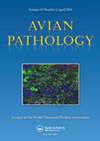抗大肠杆菌腹膜炎综合征的四价油包水乳剂灭活大肠杆菌疫苗的安全性和有效性
IF 2.2
2区 农林科学
Q1 VETERINARY SCIENCES
引用次数: 0
摘要
摘要本研究旨在制备一种对大肠杆菌腹膜炎综合征具有广泛保护作用的安全疫苗。制备了两种甲醛灭活油包水乳剂疫苗,一种疫苗含有大肠杆菌基因型A (O1:H7)、B (O78:H4)、C (O2:H1)和D (O11:H12)(疫苗A-D),另一种疫苗只含有基因型A(疫苗A)。大肠杆菌基因型来源于EPS鸡。SPF级来港白母鸡在14和18周龄时皮下接种疫苗。实验1表明,A-D疫苗皮下注射是安全的,对平均体重、产蛋量和蛋重没有影响。轻微的副作用是可以接受的。实验2评价疫苗的效力。共饲养了23组母鸡,每组16只,饲养在单独的隔离箱内。5组接种A疫苗,9组接种A- d疫苗,9组注射安慰剂。各组小鼠在26周龄时分别以同种或异种LD50进行气管内刺激。疫苗A对基因型B没有诱导保护作用,而疫苗A- d对基因型B具有完全保护作用,对基因型F和H具有几乎完全保护作用;均为血清型O78:H4。对基因型D (O11:H12)有部分保护作用,对基因型A (O1:H7)、C (O2:H1)、E (O1:H7)和G (O2:H6)无保护作用。阐明基因型/血清型之间在保护方面的显著差异的原因,即完全保护与无保护,可能会导致开发出对大肠杆菌感染具有广泛保护作用的疫苗。本文章由计算机程序翻译,如有差异,请以英文原文为准。
Safety and efficacy of an inactivated tetravalent water-in-oil emulsion Escherichia coli vaccine against the E. coli peritonitis syndrome.
Research highlights: Protection against E. coli (EPS) challenge seems to be genotype-serotype-specific.Genotype B (O78:H4) gave (almost) full protection against genotypes B, F and H (all O78:H4).Genotype D (O11:H12) incited partial protection.Genotypes A (O1:H7) and C (O2:H1) were not protective.
求助全文
通过发布文献求助,成功后即可免费获取论文全文。
去求助
来源期刊

Avian Pathology
农林科学-兽医学
CiteScore
4.50
自引率
10.70%
发文量
68
审稿时长
1 months
期刊介绍:
Avian Pathology is the official journal of the World Veterinary Poultry Association and, since its first publication in 1972, has been a leading international journal for poultry disease scientists. It publishes material relevant to the entire field of infectious and non-infectious diseases of poultry and other birds. Accepted manuscripts will contribute novel data of interest to an international readership and will add significantly to knowledge and understanding of diseases, old or new. Subject areas include pathology, diagnosis, detection and characterisation of pathogens, infections of possible zoonotic importance, epidemiology, innate and immune responses, vaccines, gene sequences, genetics in relation to disease and physiological and biochemical changes in response to disease. First and subsequent reports of well-recognized diseases within a country are not acceptable unless they also include substantial new information about the disease or pathogen. Manuscripts on wild or pet birds should describe disease or pathogens in a significant number of birds, recognizing/suggesting serious potential impact on that species or that the disease or pathogen is of demonstrable relevance to poultry. Manuscripts on food-borne microorganisms acquired during or after processing, and those that catalogue the occurrence or properties of microorganisms, are unlikely to be considered for publication in the absence of data linking them to avian disease.
 求助内容:
求助内容: 应助结果提醒方式:
应助结果提醒方式:


